
"Kiko-chan Sumairu"
Kiko-chan's Smile
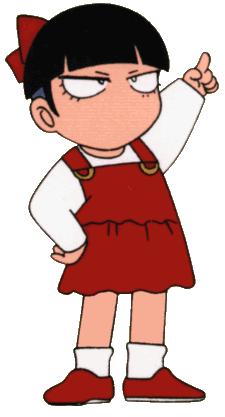
Here we
have a unique anime about a precocious preschool girl
with a very individual way of looking at life. It SEEMS as if this
would be a show for children -- but it isn't. At least, not entirely.
The show is simple and funny, but filled with satire, nostalgia, and good-natured
ironic humor of a type that only adults can fully appreciate.
It will never be released on laserdisk.
It just seems a waste that some of these lesser-known shows
are simply ignored. Three volumes of tapes were released
in Japan by Tokyo Broadcasting Service, but sales were apparently too poor
to justify continuing. Fortunately, we made SVHS source tapes, from
TV but with commercials edited out, of the entire series, with the exception
of two unimportant episodes, which were lost. The last episode was
#51. We have the TBS released commercial tapes as well. They contain 12 of
the first 15 or so episodes. (For instance, episode 2 is missing from the
commercial tapes.)
After much indecision,
we decided to use the English title "Kiko-chan's Smile."
This doesn't lose a lot in translation, though we could also have used
"Kiko-chan is Smiling", which sounds a little clumsy. The title is
meant to be a bit ambiguous, and also is written all in hiragana -- which adds
to the ambiguity, as well as being the way a child would write it. Here is the
information we were able to find on the title in Japanese:
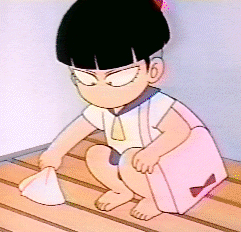
I did some very determined digging on the Internet,
and found some elusive information about "the Kiko-chan Smile." This
appears to be a reference to the warm smile of Kiko Kawashima, who married
the second son of the present Emperor of Japan, becoming Princess Akishino.
Though I couldn't find anything specific about the Princess's smile, I
found out more about her in general. The phrase "a Kiko-chan Smile"
became one adopted by the press at the time of the royal wedding.
Their Majesties' second son, Prince Fumihito,
was born on November 30, 1965. In June 1990, taking the title of
Prince Akishino, he married Kawashima Kiko, the eldest daughter of Gakushuin
University Professor Kawashima Tatsuhiko. During the 1990 wedding ceremony,
the bride wore a layered style of formal court dress called Junihitoe.
This wedding was notable because it was the first marriage in which a royal
prince was married to a woman from outside of the principal noble families
in Japan, in effect, a "commoner." In October 1991 Their Majesties'
first grandchild, Princess Mako, was born to Prince and Princess Akishino.
A second grandchild, Princess Kako, followed in December 1994.
Their Imperial Highnesses often go on diplomatic trips.
Prince and Princess Akishino visited Vietnam a few years ago. I
found a rather old photo of the royal couple inspecting a communications research laboratory,
but the link disappeared. The Princess also visited a Refugee Child center.
To make the story of the title even stranger,
I discovered that the name of one of the most famous American mimes is
"Kiko". Mimes are pantomimists, performers who act out scenes using
no sounds, and with invisible props. It seems like an amazing coincidence,
since Kiko-chan is "quite possibly the quietest kindergartener in all of
Japan" to quote the show. Could there be a connection between this famous mime and
the title of this anime? Probably not. But truth is sometimes
strange, isn't it. One wonders.
Michael Hopcroft has made a
Kiko-chan
fan site which looks really nice!
Fansubs: we are translating
and fansubbing this series, but we may not do all the episodes. That
depends on whether there are American fansub fans who will love the show. For more
information, see below.
Kiko sometimes wonders if perhaps she might want her own cat litter box.

|
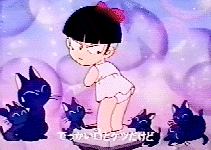
|
Kiko's parents are in love. Romance is something that
Kiko thinks should be kept private. Kiko-chan gives Mama and Papa an impatient
look whenever they get too love-struck.

|
|
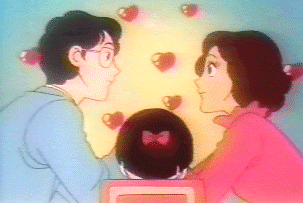
|
The first 3 episodes were translated by Emi.
Episode 4 was done by our new translator Chako Chavez.
Kiko-chan was originally a project for Barbara
to practice translating herself, but even this show is too difficult in
a lot of places. The main problem is the narrator, who uses
amazingly ornate and flowery sentences and word choice. In fact,
the verbosity of the narrator is one joke we just can't adequately
translate to English.
 Megumi is Kiko's teacher. She's only
21, this is her first classroom, and Kiko is in her class. To her,
all children are angels. Kiko seems to like her. Though
that's what Megumi wants more than anything -- it isn't necessarily good
news for Megumi to have Kiko-chan looking after her. For instance,
Kiko understands that Megumi wants a boyfriend... so Kiko decides to make
sure she gets one!
Megumi is Kiko's teacher. She's only
21, this is her first classroom, and Kiko is in her class. To her,
all children are angels. Kiko seems to like her. Though
that's what Megumi wants more than anything -- it isn't necessarily good
news for Megumi to have Kiko-chan looking after her. For instance,
Kiko understands that Megumi wants a boyfriend... so Kiko decides to make
sure she gets one!
|
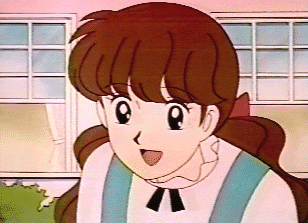
|
Ironically, the voice actress playing Kiko-chan
has the smallest part in the show. That's because
Kiko doesn't do much talking!
The main two actresses in the series actually are the two playing
Kiko's teacher, Megumi-sensei (Takeo Horiuchi), and Kiko's mother (Yumi Takada).
This isn't too unusual, since the magazine the manga appears in is marketed
to young women around 20 or so.
|
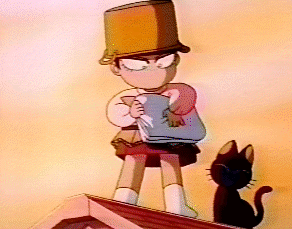
|
 When she's in trouble, Kiko dons
handy kitchen armor, grabs pillows (in case she falls) and retreats to the roof.
When she's in trouble, Kiko dons
handy kitchen armor, grabs pillows (in case she falls) and retreats to the roof.
|
Our Fansub of Volume 1: eps. 1-4
In this volume, we meet Kiko-chan! She bounces into
the story and immediately there is a battle of wills between her and her
very-very sweet but terribly naive and far-too-young teacher, Megumi-sensei.
Poor Megumi-sensei isn't quite prepared for an encounter with a child such
as Kiko-chan (who would be?) When Kiko-chan happens to notice
Megumi-sensei's secret weak point, Kiko-chan of course decides to help
her teacher out with it. Poor Megumi-sensei probably would benefit
from trauma counseling after Kiko-chan's help. (I think Megumi-sensei
has the most wonderful-sounding scream. She cries a lot too.)
Kiko-chan's cat came from outer space in an orange crate.
This may seem remarkable, but it isn't, really, because... well, he's actually
an angel, and it's just a coincidence that he looks like a cat. He
can talk too, but Kiko-chan can't understand him. He's on a mission
of happiness, with the goal of making everyone on earth happy. When
he's done, he'll be promoted to full angel and he can go back to heaven.
His first subject is Kiko-chan. However, he falls in love with the
cat next door named Rosa, who unfortunately happens to be the sweetheart
of an enormous shrine cat named Konishiki who runs the neighborhood.
This bodes trouble. Fortunately, he has amazing (and unpredictable)
powers which keep him from getting beaten to a pulp by the local gang.
His powers can't protect him when Rosa decides she likes him, though...
and the resulting 5 kittens are a big surprise! Obviously he's not
going home any time soon. By the way, his name is "Neko-chan."
This is equivalent to giving a cat the name "CAT." However, he is
actually "Shimei ni mezameta honto wa tenshi" -- a flowery phrase which we translated loosely as "apprentice
missionary angel." Everyone just calls him "Neko-chan" though.
Kiko-chan suddenly realizes what money is! She discovers
that she can get really great stuff with money. Mama and Papa decide
that they'll give her some money each time she does a household chore of
some sort, but the plan gets out of hand very quickly. If 84 yen
causes this much trouble, what will it be like when this little girl gets
her hands on some REAL money?
"Kiko-chan's Smile" is a unique anime, about a little girl who
doesn't look or act cute, but who is somehow adorably sweet, refreshingly
bright, and disconcertingly strange all at once. Please don't skip
this anime just because it doesn't look like anything you've ever seen
before. If you are a shoujo anime fan... Kiko-chan is the perfect
cure for an overdose of the typical overly syrupy and vacuous magical girl
anime.
The above plus several other short stories are in this
volume. The TV program was shown in 24 minute episodes, consisting
of three 8-minute segments, usually with a different title for each segment.
Each segment is a different story. The list below shows the titles
for the 12 segments in volume 1.
Volume 1:
1A. Invincible Kindergartener
1B. There Came an Angel from Heaven...
1C. Megumi-sensei Versus Kiko-chan
2A. An Album of Reminiscences
2B. Kiko-chan's Trip
2C. Overreacting is a Good Thing
3A. Samidare Kindergarten's Tale of Terror
3B. His First Love! He's a Real Angel.
3C. Kiko-chan's Treasures
4A. I Want Pocket Money!
4B. You're Kidding! You had Five Kittens?
4C. Twinkle Twinkle Memories
|
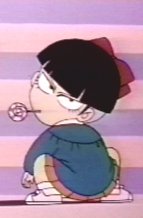
|
Sponsors, vols 1-2:
1. Al Lee (paid)
2. Koto (paid)
3. Bob Maras (paid)
4. Greg Dreher (paid)
5. Ken Hardwick (paid)
6. Micah (paid)
7. Micah (paid)
8. Ken Hardwick (paid)
|
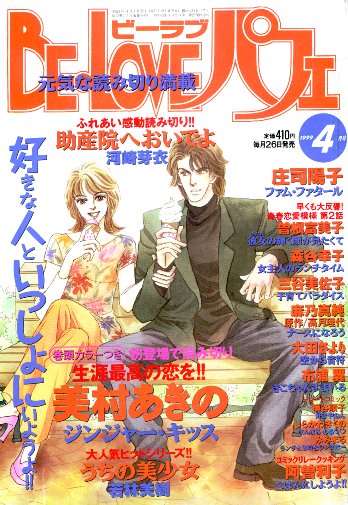
The Manga
"Kiko-chan's Smile" fits the definition of "shoujo anime".
The original manga is by Tsubasa NUNOURA, and the manga runs
in the shoujo monthly "Be-Love Parfait". A sample cover of the April
99 issue of the magazine is shown at left. This magazine contains about
400 pages per issue and is meant for the older-teen, or college girl, or
"office-lady" market. Because of the older readership, it contains
no furigana (pronunciation aids) alongside the kanji characters.
Because of the age of the readers, you might describe the magazine as "adult"
-- but this is a perfect example of how the term differs between the US
and Japan. In the US, the term would imply that the magazine contained
sexual material mostly, whereas in Japan it merely indicates a marketing
goal. "Be-Love Parfait" contains an enormous variety of stories --
ranging from the sweet and completely "G-rated" Kiko-chan stories, to stories
of steamy romances showing explicit nudity, to stories of simple romance,
office friends, and even "pregnancy stories" -- stories of having babies,
including detailed hospital scenes! In the US, such a magazine would
not be able to have such variety, because having even a single story with
nudity would cause it to be restricted and labelled, officially and unofficially
as "adults only" -- which would then cause it to gravitate towards containing
MOSTLY such material, because new readership would be specifically those
looking for "adult" entertainment. It's nice to see a magazine for
adults with such variety.
 Below you'll find a sample panel from the manga. The
artwork of the anime follows the manga fairly closely. However, the
story material of the anime differs from the manga because of the difference
in format. The manga is normally a very short piece of just 6 pages or
so -- shorter than most manga -- and therefore isn't really suited to making
a 24 minute anime. This was partly compensated for by dividing the
anime into 3 8-minute segments for each show. Even then, sometimes
each segment had to combine material from diverse manga installments, in
addition to new material sometimes, to make a complete story.
Below you'll find a sample panel from the manga. The
artwork of the anime follows the manga fairly closely. However, the
story material of the anime differs from the manga because of the difference
in format. The manga is normally a very short piece of just 6 pages or
so -- shorter than most manga -- and therefore isn't really suited to making
a 24 minute anime. This was partly compensated for by dividing the
anime into 3 8-minute segments for each show. Even then, sometimes
each segment had to combine material from diverse manga installments, in
addition to new material sometimes, to make a complete story.
|
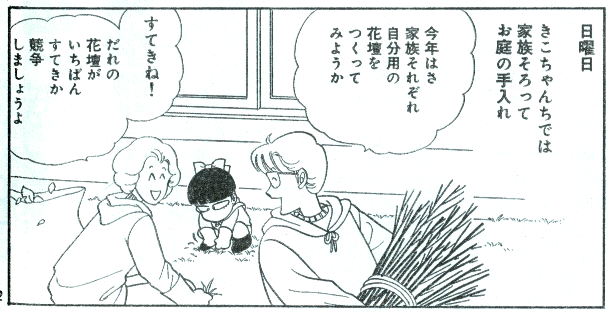
The manga has additional differences from
the anime since the "dream episodes" of the anime are entirely absent from
the manga. These "fantasy episodes" are sort of like the fantasies
of Calvin and Hobbes, except that they don't intrude on daily life, and
are "what-if" scenarios using the characters from Kiko's "real world".
When they appear in the anime, we know that they are new material which
was written especially for the anime. As the anime series progresses,
it becomes less dependant on the manga, and more an independant work.
By the end of the series, we see lots of stories which never were in the
manga.
So, what's happening in the above panel?
I haven't translated it in detail yet, but... Papa is proposing that each
of them plant their own flowers in the garden this year, and Mama thinks
the idea is really great, and wonders which of them will grow the best
flowers. Meanwhile, we see Kiko silently pulling up weeds.
One of the most special features of
both the manga and the anime is how a situation is shown to us from the
perspective of a small child, and how the reader immediately recognizes
"yes, that's how it was when I was little!" In this sense, it is
like "The BlueGreen Years." But it doesn't stop there -- Kiko
being a special child, she can interact with issues that kindergarteners
don't normally deal with -- but still, from the emotional viewpoint of
a 4 year old. Like the time she decides she wants her own checking
account, and all the peculiarly Japanese problems which arise. This
makes the story really funny. It also underscores how the manga really
ISN'T meant for young children. Though the manga is for adult women,
the anime IS meant for a mixed audience, and the addition of the "fantasy
episodes" are probably for the purpose of keeping the attention of younger
viewers.
Comments we received by email
I just watched my copy of volume 1 of Kiko-chan. It's fantabulous!!! You
all did a wonderful job, and I can't wait to see more. Even my friends
who are completely new to anime in general loved it. Thanks so much!!! [A.]
I love this show even more than I did before now that I know more of
what's going on. Kiko-chan is so scary it's cute, Megumi-sensei is a great
character, and the world of the cats is very interesting.
When will the narrator learn to control his mouth? He is VERY verbose,
which is funny in itself when it doesn't get totally out of hand.
The translation explains a lot of jokes that I didn't get before. For
example, the gag involving Kiko's first words is much more complicated
than I thought it was at first viewing when I didn't have subtitles. [M.H.]
I LOVED this! The art was really different; the OP was almost psychedelic, but I got
to like this within 5 minutes of episode 1A:) The mini eps were so cute.
I love the dynamic between Kiko-chan & Megumi-sensei. I loved all of
the signs & letters instead of talking. You really get to like Kiko-chan
quickly, even tho the ep seemed to speed by... [A.W.]
As for Kiko-chan, I again, was not looking forward to it, but a friend
said to watch it since it certainly wasn't what I thought it would be. (I
really trust her judgement since we seem to like all the same series.) The minute
I saw the opening with the dancing Kiko letters I was hooked. This anime is
certainly hilarious and very addictive and Kiko-chan is fun to watch as
she isn't completely perfect and still has some problems as a child. [J]
Hi Hi, I just wanted to say that I really like Kiko-chan's
> smile (I saw that you wanted more feedback from fans)! It's so cute and very funny! I hope
that you'll keep doing the series since it's really fun. I just
wish I had checked by earlier so I could've sponsored! Please Keep up the good work!! [A.M.]
Hello, I just saw "Kiko-chan" a few days ago and I must make a comment on
it. You see, I was originally expecting a high energy slapstick show, but
instead, I found an extremely well written show with lots of good dry
humor. It has become one of my favorite anime for the time-being. I admire you
all very much for finding and subbing this gem. If you ever need a sponsor for
vol. 3 (darn, vol. 2 is taken!), sign me up! [A.G.]
This page was designed in a generic text editor and checked in Explorer 5, Netscape 4, and Opera 5.
Last updated on 4/05/2001.









































































































































































































































































































































